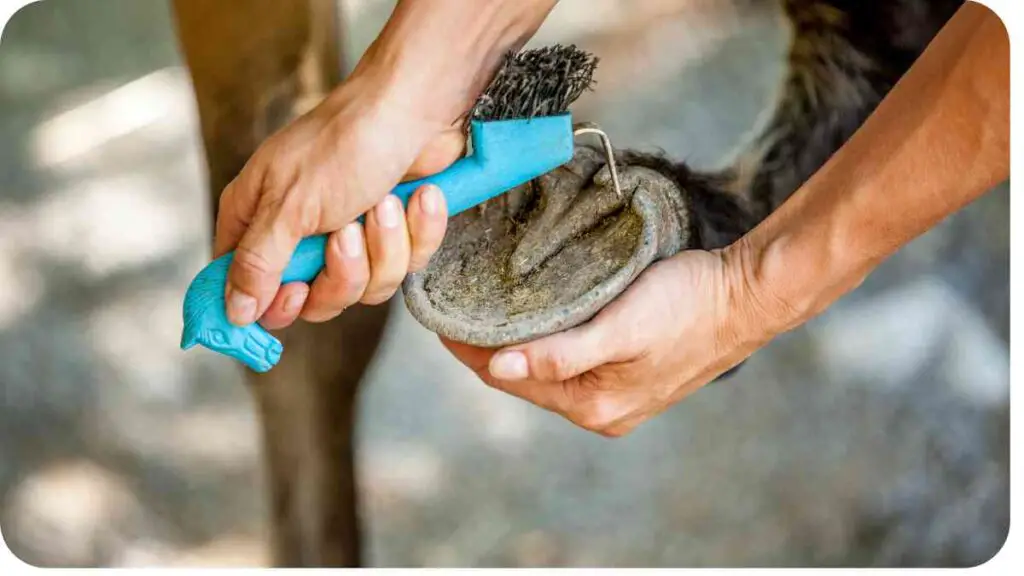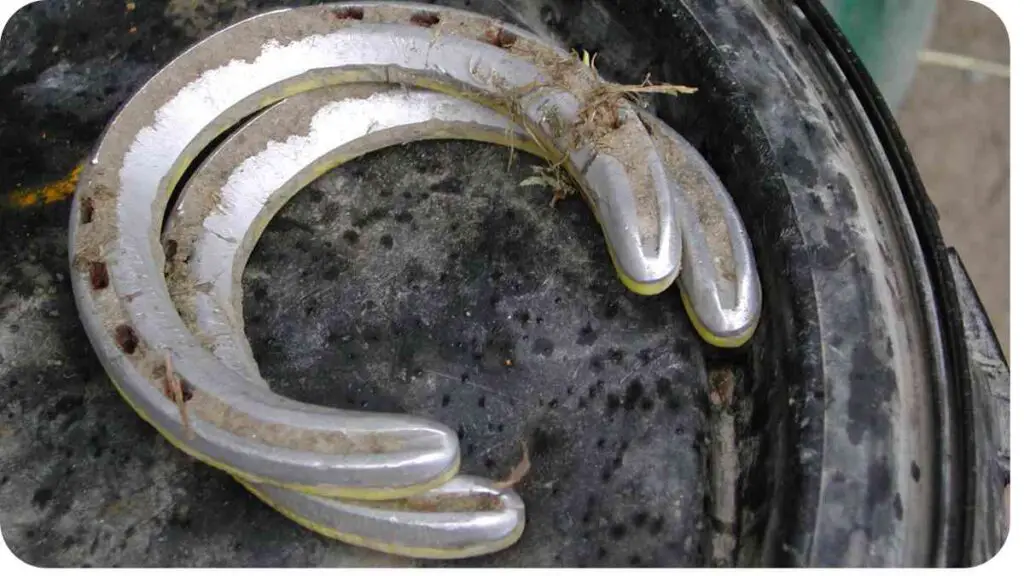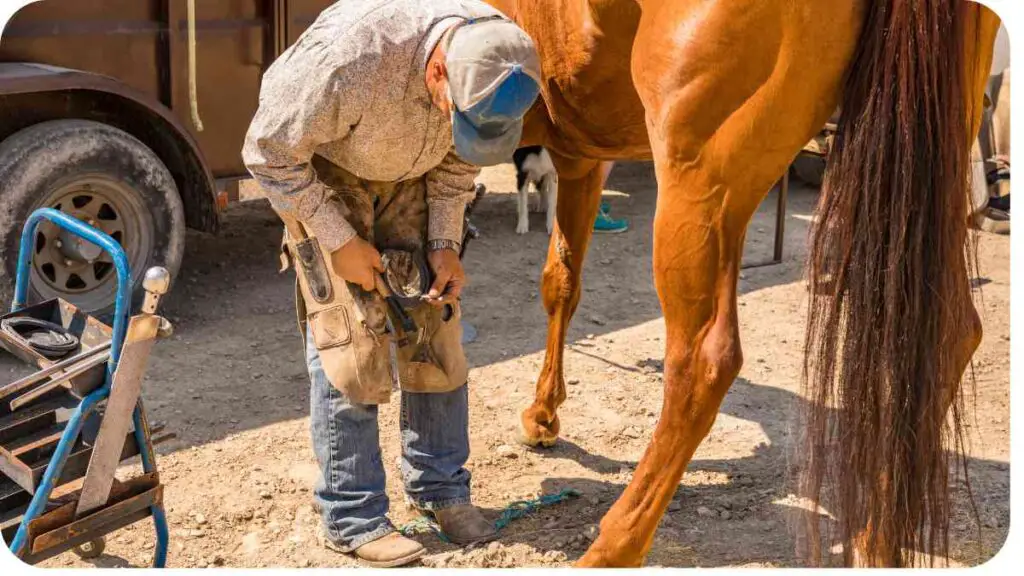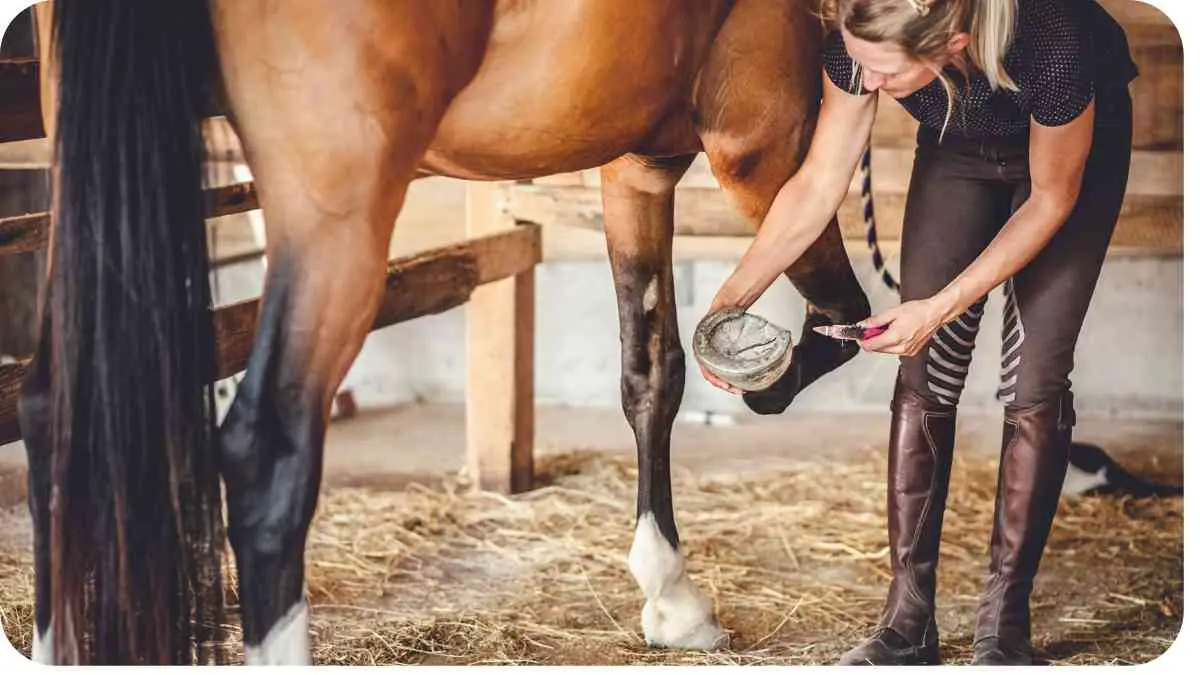As a horse enthusiast, ensuring the well-being of your equine companion is a top priority. One aspect that often raises concerns is the practice of shoeing. Questions like, “Does shoeing hurt horses?” are common among horse owners.
In this comprehensive guide, we’ll delve into the intricacies of horse hoof health, the role of shoeing, and dispel myths surrounding potential discomfort.
| Takeaway |
|---|
| Understanding the anatomy of a horse’s hoof is crucial for effective hoof care and overall well-being. |
| Proper shoeing, when done correctly, provides benefits such as wear prevention, traction, and correction of imbalances. |
| Different types of horse shoes cater to various needs, and the choice depends on factors like activity level and terrain. |
| Debunking myths around horse shoeing emphasizes the importance of distinguishing between sensitivity and actual pain in horses. |
| Regular hoof maintenance, choosing the right farrier, and ensuring proper fit contribute to comfortable and healthy shoeing. |
| Alternatives like barefoot trimming and natural hoof care offer options for those looking beyond traditional shoeing. |
| Real-life success stories underscore the positive impact of tailored hoof care in overcoming issues and promoting well-being. |
| Effective communication with the farrier and regular inspections play pivotal roles in maintaining hoof health. |
| Dietary considerations, such as providing essential nutrients, contribute to the overall strength and resilience of hooves. |
| Frequently asked questions address common concerns, offering clarity on topics like pain during shoeing and shoeing frequency. |
Importance of Horse Hoof Health

Anatomy of a Horse Hoof
Understanding the anatomy of a horse’s hoof is crucial for every horse owner. The hoof is a complex structure consisting of the hoof wall, sole, frog, and sensitive laminae. Each component plays a vital role in supporting the horse’s weight, providing shock absorption, and facilitating movement.
Proper hoof care is essential for a horse’s well-being. Regular maintenance, including effective trimming and cleaning, ensures optimal hoof health, preventing issues like lameness and discomfort.
Table 1: Components of a Horse Hoof
| Hoof Component | Function |
|---|---|
| Hoof Wall | Protective outer layer composed of keratinized cells |
| Sole | Bottom surface of the hoof, supports the inner structures |
| Frog | Wedge-shaped structure that aids in shock absorption |
| Sensitive Laminae | Connects the hoof wall to the underlying structures |
Common Hoof Problems
Horses are susceptible to various hoof problems, including such as thrush, abscesses, and laminitis. These issues can significantly impact the horse’s comfort and overall health. Regular hoof maintenance and proper care are essential in preventing and addressing these problems.
Table 2: Common Hoof Problems and Their Symptoms
| Hoof Problem | Symptoms |
|---|---|
| Thrush | Foul-smelling discharge, blackened frog |
| Abscess | Limping, heat in the hoof, increased pulse |
| Laminitis | Lameness, increased digital pulse, founder |
The Role of Horse Shoeing

Purpose of Horse Shoeing
Horse shoeing is a practice that has been employed for centuries to protect hooves from wear and tear, provide traction, and address certain hoof-related issues. While it has proven beneficial, misconceptions about its potential harm to horses persist.
While the idea of bare hooves may seem natural, understanding the potential risks is crucial. Explore the reasons why horses might benefit from protective measures like horseshoes for overall hoof well-being.
Table 3: Benefits of Horse Shoeing
| Benefit | Description |
|---|---|
| Wear Prevention | Protects hooves from excessive wear and tear |
| Traction | Enhances grip, reducing the risk of slipping |
| Correction of Imbalances | Addresses gait and conformation issues through corrective shoeing |
Different Types of Horse Shoes
There are various types of horse shoes, each designed for specific purposes. The choice of shoe depends on factors like the horse’s activity level, hoof condition, and terrain.
Table 4: Types of Horse Shoes
| Horse Shoe Type | Purpose |
|---|---|
| Steel Shoes | Durable and suitable for heavy workloads |
| Aluminum Shoes | Lightweight, ideal for performance and racing |
| Rubber Shoes | Provides shock absorption and support |
Debunking Myths: Does Shoeing Hurt Horses?
Understanding Horse Sensitivity
One common misconception is that shoeing causes pain to horses. In reality, horses are naturally sensitive animals, and their hooves are a particularly delicate area. It’s crucial to differentiate between normal sensitivity and actual pain during and after shoeing.
Exploring alternatives to traditional horseshoes, rubber shoes provide an effective and comfortable solution. Discover how these innovative hoof protection options can contribute to your horse’s overall hoof health and soundness.
Table 5: Normal Sensitivity vs. Pain Indicators
| Normal Sensitivity | Pain Indicators |
|---|---|
| Slight discomfort initially | Persistent limping or reluctance to move |
| Sensitivity to tapping on the hoof | Signs of distress, such as sweating or tail swishing |
Professional Insights on Hoof Pain
To gain a better understanding of whether shoeing hurts horses, it’s insightful to turn to experienced farriers and equine professionals. Many experts agree that when done correctly, shoeing should not cause harm. Farriers, such as emphasize the importance of a skilled and knowledgeable farrier who considers the individual needs of each horse.
Signs of Uncomfortable Shoeing
Behavioral Changes
While horses may initially exhibit some discomfort during or after shoeing, persistent behavioral changes may indicate a problem. Observing your horse’s behavior is crucial in identifying signs of discomfort, which can include resistance during shoeing, reluctance to move, or changes in temperament.
Table 7: Behavioral Signs of Uncomfortable Shoeing
| Behavioral Change | Possible Indication |
|---|---|
| Resistance during shoeing | Pain or discomfort during the process |
| Reluctance to move | Discomfort while walking or exercising |
| Changes in temperament | Irritability, aggression, or withdrawal |
Physical Indicators
In addition to behavioral changes, physical indicators can reveal whether shoeing is causing discomfort. Examining the hooves for signs such as heat, swelling, or unusual wear patterns is essential.
Timing is key when considering horseshoes. Learn about the signs and situations that indicate your horse may benefit from this protective gear. Proper assessment ensures your horse’s comfort and well-being during various activities.
Table 8: Physical Indicators of Uncomfortable Shoeing
| Physical Indicator | Possible Sign |
|---|---|
| Heat in the hoof | Inflammation or infection |
| Swelling | Indicates inflammation or injury |
| Unusual wear patterns | Uneven wear due to improper shoeing or fit |
How to Ensure Comfortable Shoeing
Choosing the Right Farrier
Selecting a skilled and experienced farrier is paramount in ensuring your horse’s comfort during shoeing. A knowledgeable farrier will consider the horse’s conformation, gait, and individual needs.
Table 9: Considerations When Choosing a Farrier
| Consideration | Importance |
|---|---|
| Experience | Demonstrated expertise in horse shoeing |
| Communication Skills | Ability to understand and address owner concerns |
| Client References | Positive feedback from other horse owners |
Regular Hoof Maintenance
Beyond the act of shoeing, regular hoof maintenance is essential for overall hoof health. This includes proper trimming, cleaning, and monitoring for any signs of issues.
Table 10: Hoof Maintenance Practices
| Maintenance Practice | Frequency |
|---|---|
| Trimming | Every 6-8 weeks, or as needed |
| Cleaning | Regularly, especially after muddy conditions |
| Monitoring for Issues | Daily checks for signs of discomfort |
Monitoring Hoof Growth
Understanding the rate of hoof growth is vital in maintaining the horse’s comfort. Regular monitoring allows you to schedule shoeing appointments at the right intervals, preventing overgrowth or potential discomfort.
Donkeys possess naturally durable hooves that often eliminate the need for shoes. Delve into the unique characteristics of donkey hooves and the reasons behind their resilience, providing insights into alternative approaches for hoof health.
Table 11: Hoof Growth Rates
| Hoof Growth Stage | Average Growth Rate |
|---|---|
| Initial Growth | Faster growth in younger horses |
| Maintenance Phase | Slower growth in mature horses |
The Importance of Proper Fit
Impact of Incorrect Shoeing
One of the primary reasons for discomfort during shoeing is an improper fit. Ill-fitting shoes can lead to a range of issues, from bruising and soreness to long-term damage.
Table 12: Consequences of Incorrect Shoeing
| Consequence | Description |
|---|---|
| Bruising | Result of pressure points or inadequate support |
| Soreness | Caused by constant friction or improper shoeing |
| Long-term Damage | Development of chronic issues if not addressed |
Measuring for the Right Fit
Ensuring the correct fit involves careful measurement and consideration of the horse’s individual characteristics. A well-fitted shoe should provide support without causing pressure points or restricting movement.
Table 13: Steps for Measuring for the Right Fit
| Measurement Step | Description |
|---|---|
| Assessing Conformation | Understanding the horse’s natural stance and gait |
| Measuring Hoof Size | Determining the appropriate length and width |
| Checking for Clearance | Ensuring adequate space for natural hoof expansion |
Alternatives to Traditional Shoeing
Barefoot Trimming
An alternative to traditional shoeing is barefoot trimming, a practice gaining popularity for its focus on maintaining the horse’s natural hoof function. This approach promotes better circulation and shock absorption.
Table 14: Pros and Cons of Barefoot Trimming
| Pros | Cons |
|---|---|
| Improved Circulation | May not be suitable for all horses |
| Enhanced Shock Absorption | Requires gradual transition |
| Natural Hoof Function | Not ideal for horses with certain issues |
Natural Hoof Care
Natural hoof care involves mimicking the conditions of the wild, where horses naturally wear down their hooves through movement. Advocates argue that this approach fosters stronger, healthier hooves.
Table 15: Principles of Natural Hoof Care
| Principle | Description |
|---|---|
| Regular Movement | Encourages natural wear and strengthens hooves |
| Balanced Diet | Essential for overall hoof health |
| Adequate Living Conditions | Promotes overall well-being of the horse |
Success Stories: Happy Hooves

Case Study 1: Overcoming Hoof Issues
Let’s dive into a real-life success story where proper hoof care made a significant difference in a horse’s well-being. In this case, a horse named Luna was struggling with recurrent abscesses and discomfort during shoeing.
Table 16: Luna’s Hoof Health Journey
| Milestone | Description |
|---|---|
| Initial Hoof Issues | Luna experienced abscesses and discomfort during shoeing |
| Transition to Barefoot | The decision was made to transition Luna to barefoot trimming |
| Gradual Adaptation | Luna’s hooves were gradually trimmed to adapt to the new approach |
| Improved Hoof Health | Over time, Luna’s hooves strengthened, and abscess occurrences decreased |
Case Study 2: Transitioning to Barefoot
Another success story involves a horse named Thunder, who faced issues with traditional shoeing due to sensitivity. The owner decided to explore barefoot trimming as an alternative.
Table 17: Thunder’s Transition to Barefoot
| Milestone | Description |
|---|---|
| Sensitivity with Shoeing | Thunder displayed signs of discomfort during traditional shoeing |
| Barefoot Transition Plan | The owner, with guidance from a farrier, devised a plan to transition to barefoot |
| Gradual Adjustment | Thunder’s hooves were gradually conditioned to the change |
| Improved Comfort | Thunder adapted well to barefoot trimming, showing increased comfort |
Tips for Horse Owners
Regular Hoof Inspections
To ensure your horse’s hoof health, conduct regular inspections. Look for signs of damage, unusual wear, or changes in hoof shape. Early detection allows for prompt intervention.
Table 18: Tips for Regular Hoof Inspections
| Inspection Tip | Frequency |
|---|---|
| Check for Cracks and Bruises | Weekly |
| Assess Sole and Frog Health | Bi-weekly |
| Monitor for Uneven Wear | After every ride |
Communicating with Your Farrier
Maintaining open communication with your farrier is crucial in ensuring your horse receives the best hoof care. Discuss any concerns or observations you have about your horse’s behavior or hoof health.
Table 19: Effective Communication with Your Farrier
| Communication Tip | Importance |
|---|---|
| Share Behavioral Observations | Insights into your horse’s comfort during shoeing |
| Discuss Any Changes in Activity | Adjustments may be needed based on workload |
| Mention Dietary Considerations | Nutrition can impact overall hoof health |
Dietary Considerations
A well-balanced diet contributes significantly to hoof health. Ensure your horse receives the necessary nutrients for strong and resilient hooves.
Table 20: Nutrients for Hoof Health
| Essential Nutrient | Role in Hoof Health |
|---|---|
| Biotin | Supports hoof growth and integrity |
| Zinc | Essential for the formation of hoof tissue |
| Omega-3 Fatty Acids | Contributes to overall hoof strength |
FAQs about Horse Hoof Health
Can Horses Feel Pain During Shoeing?
The common concern about whether horses feel pain during shoeing stems from a misunderstanding of their natural sensitivity. While some sensitivity is normal, especially during the initial stages of shoeing, persistent pain is not.
Table 21: Addressing Pain Concerns
| Question | Answer |
|---|---|
| Is some sensitivity normal? | Yes, initial discomfort is common and usually temporary |
| How to differentiate pain from sensitivity? | Monitor for signs of distress and consult with your farrier if concerns arise |
How Often Should a Horse be Shod?
The frequency of shoeing depends on various factors, including the horse’s activity level, hoof growth rate, and terrain. A general guideline is every 6-8 weeks, but individual needs may vary.
Table 22: Factors Affecting Shoeing Frequency
| Factor | Impact on Shoeing Schedule |
|---|---|
| Activity Level | More active horses may need more frequent shoeing |
| Hoof Growth Rate | Faster-growing hooves may require more frequent attention |
| Terrain | Hard or abrasive terrain may cause more wear and tear |
Conclusion
Ensuring the comfort and health of your horse’s hooves is a responsibility that every horse owner shares. By understanding the anatomy of a horse’s hoof, the role of shoeing, and debunking myths surrounding potential discomfort, you can make informed decisions to promote optimal hoof health.
Regular hoof maintenance, choosing the right farrier, and being aware of signs of discomfort are essential steps in this journey. Whether opting for traditional shoeing or exploring alternatives like barefoot trimming, the key is to prioritize your horse’s individual needs.
Success stories like Luna and Thunder exemplify the positive impact that proper hoof care can have on a horse’s well-being. By incorporating regular inspections, effective communication with your farrier, and considering dietary factors, you can contribute to strong, healthy hooves.
In the end, the question of whether shoeing hurts horses is best answered by attentive care, expert guidance, and a commitment to the well-being of your equine companion. By following the tips and insights shared in this guide, you are on your way to ensuring that your horse’s hooves stay happy and healthy for years to come.
Further Reading
For more in-depth insights into horse shoeing and hoof health, consider exploring the following resources:
- Why Do Horses Need Shoes? A Comprehensive Guide
- This guide provides a detailed explanation of why horses may need shoes, exploring various aspects of horse shoeing. It’s a valuable resource for understanding the rationale behind this common practice.
- Exploring the Importance of Horseshoes
- Delve into the significance of horseshoes and their role in maintaining hoof health. This resource offers insights into the considerations that lead horse owners to opt for shoeing.
- Corrective Shoeing for Horses: A Guide to Solutions
- This guide focuses on corrective shoeing, providing valuable information on how it can address specific issues in horses. If you’re interested in solutions beyond regular shoeing, this resource is worth exploring.
FAQs
Q: Is shoeing necessary for all horses?
- A: Not necessarily. The need for shoeing depends on factors such as the horse’s activity level, hoof health, and the terrain they are regularly exposed to.
Q: Can horses feel pain during the shoeing process?
- A: While some sensitivity is normal, persistent pain is not. Properly done shoeing, by a skilled farrier, should not cause undue discomfort.
Q: How often should a horse be shod?
- A: The frequency of shoeing varies based on factors like the horse’s activity level, hoof growth rate, and the type of terrain they traverse. Typically, it’s recommended every 6-8 weeks.
Q: What are the alternatives to traditional shoeing?
- A: Alternatives include barefoot trimming and natural hoof care. These approaches focus on maintaining the horse’s natural hoof function.
Q: How can I ensure the right fit for my horse’s shoes?
- A: Ensuring the right fit involves careful measurement and consideration of the horse’s individual characteristics. Working with a skilled farrier is crucial for a proper fit.

Hi there! My name is Hellen James, and I’m a horse riding expert. I’ve been riding horses since I was just a kid—and it’s been my passion ever since. But getting started with horse riding can be overwhelming. There’s so much to learn! If you’re looking for a way to get started and make sure you’re doing it right, I’m here to help.


